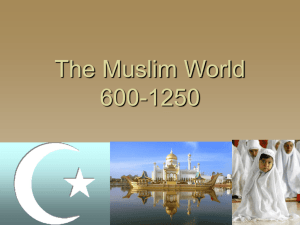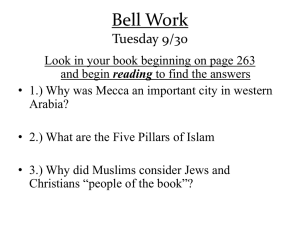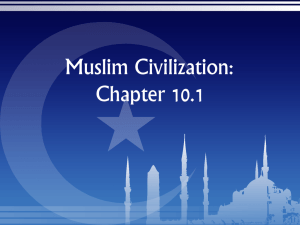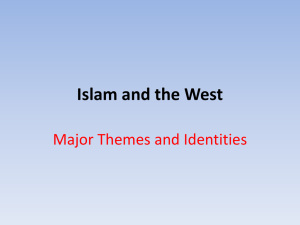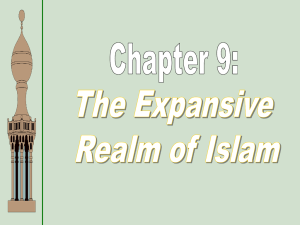9. Rise of Islam - Newsome High School
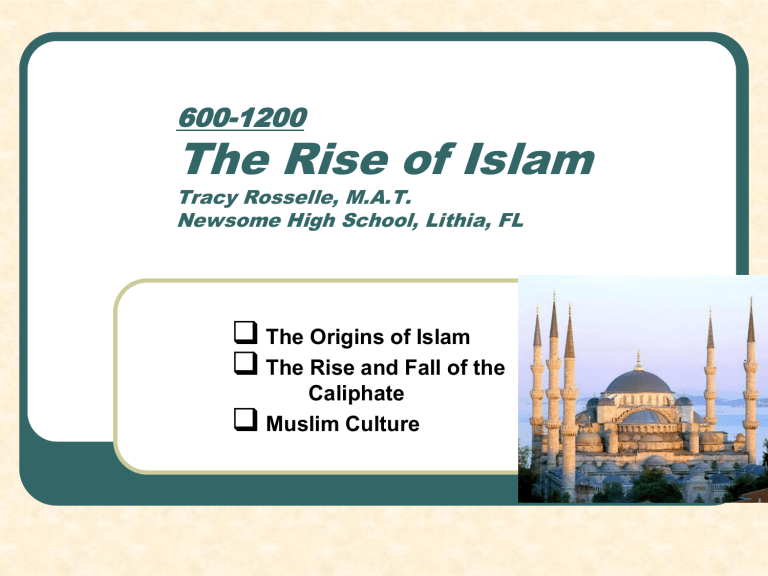
600-1200
The Rise of Islam
Tracy Rosselle, M.A.T.
Newsome High School, Lithia, FL
The Origins of Islam
The Rise and Fall of the
Caliphate
Muslim Culture
The origins of Islam
Although vast empires emerged in the classical world (and they were often linked through trade), no single civilization tied together large portions of the Western or Eastern Hemisphere until followers of a new religion – Islam – did so beginning in the seventh century.
Islam literally means “submission, the self-surrender to the will of the one, true God, Allah.”
Within decades of its founding, Muslims (those who practiced Islam, following the faith of its prophet, Muhammad ) had conquered an empire extending from Spain in the west to Central Asia in the east – an empire combining the classical civilizations of Greece, Egypt and
Persia.
For this reason, some scholars refer to it as the first global civilization , though it was not nearly global in the literal sense because expansion a) was halted in Europe on the Iberian peninsula, b) never reached northern or eastern Eurasia, and c) failed to expand to the Americas.
Desert beginnings
In the scrub zones on the edges of the desert, a wide variety of Bedouin , or nomadic, cultures had developed based on camel and goat herding. Here tribes and clans were dominant rather than cities and regional kingdoms. This bedouin world shaped the career of
Muhammad.
And it all arose from an unlikely place – the Arabian peninsula, most of which is some of the most inhospitable desert in the world.
The peninsula is more than a thousand miles from both north to south and east to west, but only a tiny strip of fertile land in the south and a few oases can support agriculture.
Central location = trade
But Arabia is a crossroads of three continents –
Africa,
Europe and
Asia – perfectly placed along major ocean and land trade routes.
Oasis in the sand
Supplied by underground springs or small rivers, oases were dotted by date palms and became the sites of towns that attracted caravans so that camels could be watered and traders fed and rested in the shade.
With their concentrated wealth, food and water, oases were often targeted by Bedouin raiders.
Arabic religion before Islam
After the camel was domesticated in the second century
BCE, Bedouins began participating in the caravan trade themselves, becoming major carriers of goods between the Persian Gulf and the Mediterranean Sea.
Each tribe
– ruled by a sheikh , chosen from a leading family by a council of elders – was autonomous but felt a general sense of allegiance to the larger unity of all the clans in the region.
In pre-Islamic times, Arabs were polytheistic, with the supreme god Allah presiding over a community of spirits.
The faith was communal, without priests.
Spirits were believed to inhabit natural objects, such as trees, rivers and mountains.
Arab religion before Islam
(cont.)
The supreme deity was symbolized by a sacred stone, and each tribe claimed its own stone.
But by the time of
Muhammad (570-632), a massive black meteorite – housed in a central shrine called the Ka’ba in the commercial city of Mecca
– had come to possess especially sacred qualities.
The Ka’ba is the most sacred site of the
Islamic faith. Wherever Muslims pray, they are instructed to face Mecca … to thus become a spoke of the Ka’ba, the holy center of the wheel of Islam. All
Muslims are encouraged to visit the
Ka’ba at least once in their lifetime.
The role of Muhammad
Muhammad:
was born in Mecca to a merchant family and orphaned at 6 to be raised by his grandfather and uncle.
received little schooling and began working in the caravan trade as a very young man.
at 25 became a manager for a wealthy widow – a 40year-old businesswoman named Khadijuh (kah-DEEjuh) – who he later married.
apparently grew troubled by the widening gap between the Bedouin values of honesty and generosity and the greed of the commercial elites in the city.
began to visit the nearby hills to meditate in isolation.
The role of Muhammad
A visit by the angel Gabriel
At about 40, Muhammad is said to have heard the voice of the angel
Gabriel, telling him he was the messenger of Allah.
Muhammad became convinced he was the last of the prophets
familiar with Jewish and Christian beliefs, he thought Allah had already revealed himself in part through Moses and Jesus … and the final revelations were being given to him.
The angel Gabriel
Muhammad and
Abraham
Completed in Jerusalem in 691, the
Dome of the Rock marks a convergence of Islam and Judaism.
The rock is where Muslims say
Muhammad ascended to heaven to learn of Allah’s will before returning to Earth to spread the message.
Situated on the site of the Jewish temple destroyed by the Romans in
70 CE, the exact same spot is where Jews say Abraham was prepared to sacrifice his son Isaac.
The Dome of the Rock
The threat of monotheism
Muhammad began preaching publicly in Mecca by 613
(his first followers were Khadijah, close friends and relatives), but initially his message was resisted
many
Meccans either thought he was a charlatan or feared the message of monotheism, thinking neglect of traditional
Arab gods would reduce the prestige of Mecca as a pilgrimage center.
After three years, his proselytizing had yielded just 30 followers.
In 622, he and his closest supporters retreated north from
Mecca to Yathrib, which was later named Medina
, or “city of the Prophet” this flight (or “migration”) is known in history as the hijra and marks the first date on the official calendar of Islam.
Forming the umma … conquering Mecca
At Medina, Muhammad initially failed to convert the
Jewish community but won support from others in the city and Bedouins in the countryside … from which he formed the first Muslim community, or umma .
By 630 he had marshaled enough supporters to bring an army of 10,000 back to Mecca, which surrendered.
He declared the Ka’ba a sacred shrine of Islam and ordered its hundreds of idols of the traditional faith destroyed.
Muhammad died just two years later just as Islam was beginning to spread throughout the peninsula, and his revelations were later transcribed into the Quran – the holy book of Islam.
The teachings of Muhammad:
Like Christianity and Judaism, Islam is monotheistic.
Allah is the all-powerful being who created everything.
Those who seek salvation and an afterlife in eternal paradise must subject themselves to the will of Allah.
Unlike Christianity, Islam makes no claim to the divinity of its founder (i.e., Muhammad was just a man, a prophet like Abraham, Moses and other figures of the Old
Testament).
The Quran contains 114 suras (chapters) drawn together by a committee after Muhammad’s death … and combines ethics, political theory and a code of law along with its sacred texts.
The teachings of Muhammad
Fundamental tenets
All Muslims must carry out five duties, properly known as the Five Pillars of Islam :
Faith – testify to the following: “There is no God but Allah, and Muhammad is the Messenger of Allah.”
Prayer – face toward Mecca and pray five times a day, at a mosque or wherever; in public at mid-day Friday.
Alms – give money for the poor, through a special religious tax.
Fasting – fast between dawn and sunset during holy month of Ramadan (the ninth month of the Islamic lunar-based calendar, when Allah is said to have revealed the revelations of the Quran).
Pilgrimage – if physically and financially able, perform the hajj , or pilgrimage to Mecca, at least once.
Ulama and the Sharia
Every Muslim is expected to worship Allah directly, so
Islam has no priests or central religious authority … though it does have a scholar class called the ulama (ooleh-MAH ) , which drew up a law code called the sharia , to provide believers with a set of prescriptions for regulating their daily lives.
The sharia combines the guidance from the Quran and
Muhammad’s example for the proper way of living
(including the Hadith , a collection of his sayings which supplement the holy scriptures), which could be very strict: Muslims were forbidden to gamble, to eat pork, to drink alcohol … contacts between unmarried men and women were discouraged, and marriages were to be arranged ideally by the parents.
From religious doctrine to a way of life
The sharia also offered precise guidance on family life, inheritance, slavery, business transactions, crime and political authority in the dar al-Islam (a term used to refer to those lands under Muslim government).
Thus, Islamic holy law developed into something more than religious doctrine: a complete social and ethical framework for living.
Interestingly, the historical analysis of the Quran remains hampered by the fact that the earliest known versions of it lack the diacritical marks that modern Arabic uses to clarify meaning
so much of the text can be interpreted in varying ambiguous ways.
The rise and fall of the caliphate
Following Muhammad’s death, Muslims saw no separation between political and religious authority … and so what would become the Islamic Empire was a theocracy .
Muslims have never agreed whether he named a successor, and although he had several daughters, he left no sons
in male-oriented society of the day, that left the question: Who would lead the community of the faithful?
Closest followers selected Abu Bakr , a wealthy merchant from Medina and Muhammad’s father-in-law, as the first caliph ( khalifa
, literally “successor”).
Caliph – temporal leader of the Islamic community as well as religious leader, or imam
rule known as caliphate.
Building an empire
Muhammad had used the tribal custom of the razzia , or raid, in struggling with his enemies, and now Abu
Bakr and his three elected successors (Umar,
Uthman and Ali – all associates of Muhammad and together known as the “rightly guided” caliphs) used the same custom to quell factional Bedouin tendencies and expand the Islamic movement.
This is known as jihad , or “striving in the way of the
Lord,” (an inner struggle against evil) though it’s sometimes translated as “holy war” (armed struggle against unbelievers).
Reasons for early success
The armies under the “rightly guided” caliphs made great progress in fulfilling Muhammad’s desire to expand the
Islamic faith northward, conquering by 661 Syria and lower
Egypt, which were part of the Byzantine Empire, and parts of the Sassanid Empire of Persia.
Several reasons explain the success:
highly motivated Muslims believed dying in battle guaranteed place in paradise.
armies were well disciplined and expertly commanded.
Byzantine and Sassanid empires were weakening.
Reasons for early success (cont.)
those persecuted under the empires to the north (i.e.,
Byzantines not supporting the official religion of
Christianity and Persians not supporting
Zoroastrianism) welcomed the Muslim invaders and were attracted by the appeal of the message of Islam, which offered equality and hope in this world.
the Quran forbade forced conversion
Christians and Jews seen as “people of the book” and received special consideration … paid a poll tax each year in exemption from military duties.
although non-Muslim lives were restricted in some ways (e.g., Christians and Jews could not spread their religions), Muslim conquerors treated their new subjects in a fairly tolerant fashion for the day.
Internal conflict and a split
Substantial battlefield gains in the decades following
Muhammad’s death couldn’t prevent political disunity.
Ali – the last of the “rightly guided” caliphs, and
Muhammad’s cousin and son-in-law – was elected successor after Uthman’s murder in 656 … amidst a civil war in which his right to rule was challenged by the governor of Syria.
When Ali too was assassinated in 661, the elective system of choosing a caliph died with him – becoming instead a dynastic heritage.
The Umayyads (the family of the Syrian governor) then came to power and ruled for more than a century.
The rule of the Umayyads:
Internal factional disputes
moved capital from Mecca to Damascus
easier to control expanding territories but Arab Muslims felt it was too far away.
moved away from the simple life of “rightly guided” caliphs and surrounded themselves with wealth, ceremony, even decadence … like non-Muslim rulers, in the eyes of critics.
Sunni-Shia split – A group called the Shia (the “party” of Ali, of which members are called Shiites) resisted Umayyad rule, insisting the caliph should be descendant of the Prophet. Umayyads and those who did not outwardly resist them later became known as
Sunni (more than 80% of today’s Muslims remain part of this
“orthodox” sect), meaning followers of Muhammad’s example.
Sufi – Another sect that rejected the luxurious life of the Umayyads; these mystics became most effective Islamic missionaries.
The rule of the Umayyads:
Continued Arab expansion
launched new attacks at both ends of Mediterranean world in early 8th century.
armies moved across North
Africa, conquering the primarily pastoral Berbers before crossing the Strait of Gibraltar and occupying southern Spain.
By 725 most of Iberian peninsula had become a Muslim state, with its center in Andalusia … but seven years later, an Arab force pushing into southern France was fought back by the Franks (with an army commanded by Charles Martel) at the Battle of Tours
traditionally viewed as saving Europe from falling into Muslim hands, but some historians believe internal exhaustion would have forced retreat anyway.
The rule of the Umayyads:
Continued Arab expansion (cont.)
another Muslim force attacked Constantinople, hoping to destroy the Byzantine Empire …
but Byzantines used Greek fire (petroleum-based compound containing quicklime and sulfur) to destroy the Muslim fleet, thereby blocking the Arab invasion of
Eastern Europe and indirectly Christian Europe
uneasy frontier now between Byzantine Empire and
Islam in southeastern Asia Minor.
Islamic power was further consolidated in
Mesopotamia, Persia and Central Asia.
The rule of the Abbasids:
Internal rebellion brought down the Umayyad caliphate in 750, when the Abbasids took control of the empire.
The Abbasid caliphate would extend to 1258 – more than half a millennium, before it was finally destroyed by the Mongols – but politically it would begin to fragment by the second half of the
9th century, becoming essentially a figurehead as regional principalities revealed the political diversity of its sprawling empire.
The Abbasids murdered all the Umayyad rulers except a prince who escaped to Spain , where he established what would become a distinctively tolerant Islamic culture blending Roman,
Germanic and Jewish traditions with those of the Arabs and
Berbers
Muslims called the Iberian territories here al-
Andalus, and it was centered at Cordoba – a culturally rich and thriving city with writers and artists and many more people than elsewhere in Europe.
The rule of the Abbasids:
The Abbasid caliphs brought political, economic, and cultural change to the world of Islam.
They tried to break down distinctions between Arab and non-Arab Muslims
all now allowed to hold both civil and military offices, which opened up
Islamic culture to the influences of occupied civilizations and thereby becoming more cosmopolitan.
Many Arabs began to intermarry with the people they had conquered, and now many people from North
Africa and the eastern Mediterranean began to consider themselves Arab.
The rule of the Abbasids:
When in 762 the Abbasids built a new capital city at Baghdad
– on the Tigris river much farther to the east than the
Umayyad capital at Damascus and more suitable as a nexus for trade – Persian cultural influence came to the fore.
Judges, merchants and government officials now seen as ideal citizens – rather than the previous warrior ideal … which meant that the Abbasids were much less a conquering dynasty than the Umayyads .
In designing their administration, they relied heavily on
Persian techniques of statecraft and bureaucracy (they ruled autocratically, more as kings than spiritual leaders) … and this increasingly regal pomp and circumstance was also probably a natural consequence of the growing power and prosperity of the empire.
The rule of the Abbasids:
Instability lurked, however:
disputes over succession were common.
rising wealth (Baghdad became the center of an enormous commercial market and home to 900,000 people by 900 CE) bred financial corruption.
the luxurious and perhaps hedonistic life of the caliph
(rumored to have thousands of concubines) and of the political and economic elites of Baghdad undermined
Arab society (e.g., divorce was common, alcohol was consumed, etc.).
provincial rulers were breaking away, establishing own independent dynasties.
The decline of the Abbasids:
Into this mix moved the Saljuq Turks , a nomadic people from Central Asia who had converted to Islam and flourished as military mercenaries for the Abbasid caliphate.
They moved gradually into Iran and Armenia, and by the mid-11th century had occupied the eastern provinces of the Abbasid empire.
In 1055, a Turkish leader captured Baghdad and assumed command of the empire with the title of sultan
(“holder of power”).
The Abbasid caliph remained the chief representative of
Sunni religious authority, but the real military and political power rested in the hands of the Saljuq Turks.
City life
Muslims combined and preserved the traditions of many peoples and also advanced learning in a variety of areas.
Society
Science and math
House of Wisdom
Arts and literature
City life, thanks to trade
Much has been written about the cosmopolitan, urban aspects of the Muslim civilization. As a point of comparison, around 900
CE Baghdad’s population approached 1 million when Rome’s once-comparable population had plummeted to less than
50,000 … and when Cordoba had hit 200,000, Paris stood at just 38,000.
Much of this had to do with the centrality of the Muslims to the thriving interregional trade network.
To encourage the flow of trade, Muslim money changers in cities throughout the empire set up banks, which issued letters of credit called sakks (sakk was pronounced in Europe as
“check”). Thus a Muslim merchant in India didn’t have to carry around vast sums of money but instead could cash a check drawn on his bank in Baghdad.
City life
New foods, better diets and paper
The growth of cities also came from:
the introduction of new crops from the east – everything from sugarcane and rice to eggplants and mangoes.
improved agricultural methods, which increased the food supply and improved diets.
Cities became home to industrial production, such as textiles
(thanks to the introduction of cotton from India), pottery, glassware, leather (the importance of which to pre-modern societies cannot be overstated), iron and steel.
Paper manufacturing also became important to urban centers as records were increasingly complex (the technology was introduced to the Arab world after Chinese prisoners of war were taken in 751).
Society: classes and women
Baghdad’s multicultural population was typical of
Muslim cities of the 8th and 9th centuries. It was made up of four classes: 1) upper class included those born
Muslim; 2) the second class were converts to Islam; 3) third were “protected people” including Christians and
Jews; and 4) the lowest class consisted of slaves, all non-Muslim and most prisoners of war working as domestic servants or military warriors.
The role of women: Although the Quran and sharia established a patriarchal society, in many ways Muslim women had more economic and property rights than
European, Indian and Chinese women. They were seen as honorable individuals, not property, and equal to men before Allah .
Science and math
Muslim scholars made advancements in astronomy, optics, chemistry, math and medicine. Among other things, they preserved and later passed on to
Europeans the classical heritage of
Greek thinkers.
Muhammad stressed learning and scholarship, and both the Umayyads and
Abbasids preserved and expanded scientific and philosophical knowledge
at House of Wisdom , a library-academy-translation center in Baghdad, scholars of different cultures and beliefs worked side by side translating texts from
Greece, India, Persia and elsewhere into Arabic.
Science and math
Astronomy and algebra
Studying the skies was needed to get a correct lunar calendar for marking religious periods such as the month of
Ramadan, and it helped fix the locations of cities so that worshippers could face toward Mecca.
Muslims were aware the earth was round centuries before European mariners proved it.
Islamic scholars adopted and passed on the numerical system of India, and a
9th-century Persian mathematician founded the discipline of algebra ( aljabr ).
The astrolabe was an early scientific instrument that could calculate time, celestial events and relative position.
Arts and literature
The art of Islam is a blend of Arab, Turkish and Persian traditions.
Arabs developed a sense of rhythm and abstraction
repetitive geometric ornamentation.
Turks
abstraction in figurative and nonfigurative designs.
Persians added lyrical, poetical mysticism.
The famous 9th-century mosque in
Cordoba
– with its 514 columns supporting double horseshoe arches
– is considered one of the wonders of world art and architecture.
Geometric designs can be found in everything from poetry to architecture. The art of beautiful, ornamental handwriting
– or calligraphy – developed because Muslims believed only Allah can create life … so images of living things were discouraged.
Arts and literature
Persian influence
Arabic was the language of religion, theology, philosophy and law, but
Persian was the principal language of literature, poetry, history and political reflection.
Poet Omar Khayyam ( Rubaiyat ) didn’t write down his poems, but rather composed them orally over wine with friends at a neighborhood tavern (many later transcribed years after his death). Key themes: impermanence of life, impossibility of knowing God, disbelief in afterlife
more popular among modern skeptics in the West than in Middle
East.
Arts and literature
The Arabian Nights
The Arabian Nights (or The
Thousand and One Nights ) was a collection of folk tales, fables and romances from India and
Persia that Muslims elaborated upon beginning in 10th century.
Translations became popular in
19th century as Western readers developed taste for stories set in exotic locales.
Story of Aladdin and the Magic
Lamp was an 18th-century addition.
Sources

